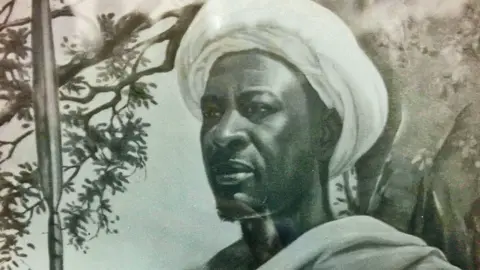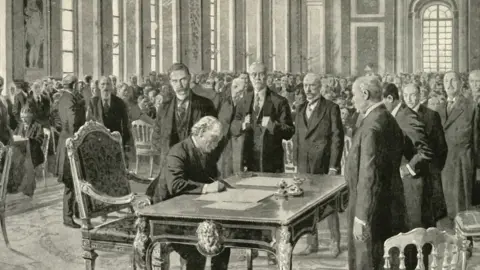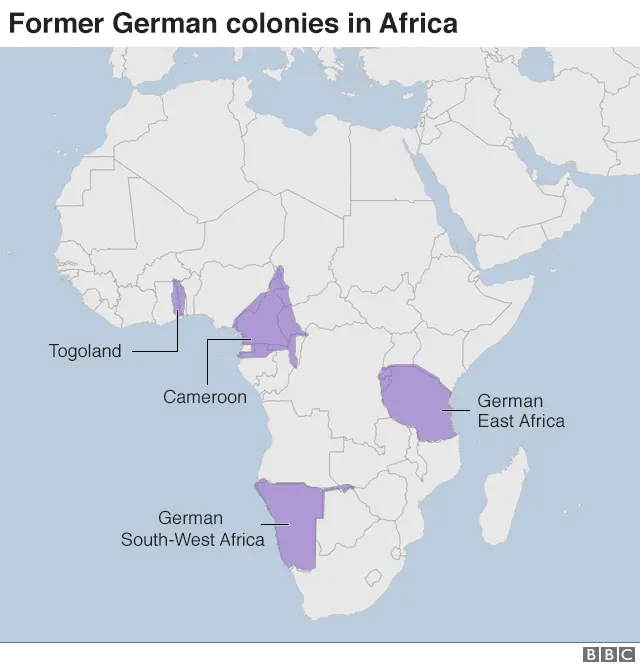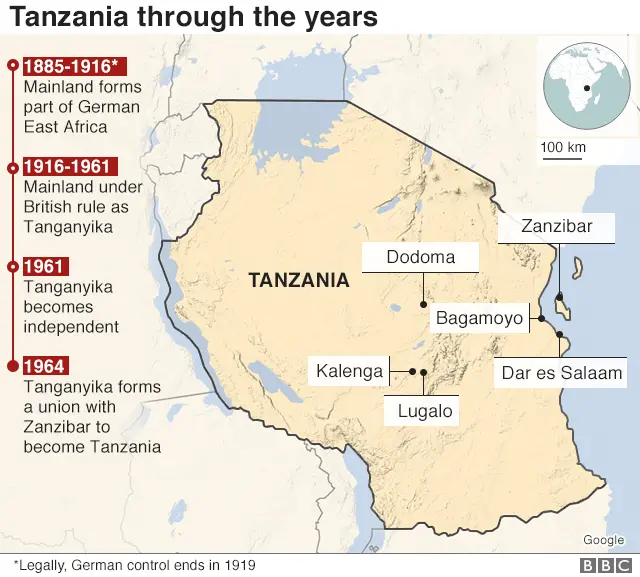Why is a Tanzanian chief's skull mentioned in the Versailles Treaty?
 National Archives
National ArchivesThe Treaty of Versailles, signed exactly a century ago, reshaped Europe in the wake of World War One. So why, within its many hundreds of clauses, does the treaty refer to the decapitated head of an African anti-colonial hero?
Chief Mkwawa's skull now sits on a plinth, protected by a glass box, in a tiny museum in a small town in central Tanzania. But like a trophy, it once adorned the house of a colonial official in Germany's administrative centre in Bagamoyo, before being spirited away to Germany at some point at the beginning of the 20th Century.
The skull was used as a symbol to intimidate the Wahehe people, who the chief had led in a fierce rebellion against the German colonisers.
So successful was his campaign in the 1890s that a bounty was put on his head by the Germans. He is believed to have eventually taken his own life in 1898, rather than submit to the humiliation of being captured, as he sheltered in a cave that was encircled by German soldiers.
Two decades later, the fate of his skull was on the minds of the diplomats who spent months arguing over the settlement of World War One.

The Treaty of Versailles, which established the League of Nations and detailed the reparations Germany had to pay for starting the conflict, runs to tens of thousands of words amounting to 440 clauses, or articles, plus several annexes.
Chaotic negotiations
Hundreds of diplomats from around the world, holed up in the French capital, Paris, drafted and redrafted the articles. The chaotic nature of the process may have allowed the fate of Chief Mkwawa's skull to be snuck into the text - largely thanks to the efforts of Horace Byatt, a British colonial administrator in East Africa.
 Getty Images
Getty ImagesHistorian Jeremiah Garsha has found a letter Byatt sent just three days after the end of the war in November 1918, which lobbied to have the skull returned from Germany, saying it would give "satisfaction" to the Wahehe people, offering "tangible proof in the eyes of the natives that German power has been completely broken".
It is likely he had another motive - to show that the British, who had seized control of German territories in East Africa, were now in charge. But while the four leaders of the main allied powers gave the idea a sympathetic hearing, they were not convinced.
Mr Garsha has found minutes from one of their meetings in February 1919, in which it was said that the impact on the Wahehe people was "hardly sufficient for the inclusion [of the skull] in the venerable peace treaty".
'Craniological curiosity'
That should have been the end of it, but some in the British camp, including Colonial Secretary Viscount Milner, were keen on the issue and spotted an opportunity in the section of the treaty that dealt with reparations.

Chief Mkwawa's full name:
- Born in 1855 and named Ndesalasi, meaning "Troublemaker"
- As an adult later named Mtwa Mkwava Mkwavinyika Mahinya Yilimwiganga Mkali Kuvago Kuvadala Tage Matenengo Manwiwage Seguniwagula Gumganga, meaning: "A leader who takes control of the forests, who is aggressive to men and polite to women, who is unpredictable and unbeatable, and who has the power that it is only death who can take him away"
- The Germans shortened this to Mkwawa, pronounced "Mkwava" - but it is now commonly pronounced as it is spelt

Some countries wanted to see Germany return artefacts and art works and Mr Garsha argues that it was Milner's description of the skull as a "craniological curiosity" that allowed it to be seen as an object of art.
And so under a section headed "special provisions" and sandwiched between demands from France and Belgium sits article 246: "Within six months… Germany will hand over to His Britannic Majesty's Government the skull of the Sultan Mkwawa, which was removed from the Protectorate of German East Africa and taken to Germany."
However, the skull was not returned within six months - it took another 35 years for this to happen.

What WW1's end meant for Africa
By Martin Plaut


The Treaty of Versailles helped shape modern Africa as Germany renounced sovereignty over its former colonies and Article 22 converted these into League of Nations mandate territories, to be run by the former allied powers.
Togoland was divided between France and Britain, the French part becoming modern-day Togo and the British part joining Ghana. Kamerun (Cameroon) was also partitioned between the two allies. Ruanda (Rwanda) and Urundi (Burundi) were given to Belgium. Britain received German East Africa (Tanzania), while German South-West Africa (Namibia) went to South Africa.
South Africa's mandate over Namibia became hotly contested because of the imposition of apartheid, and was finally terminated by the UN in 1961. The partition of Cameroon is a factor in the current conflict between the country's Anglophone and Francophone populations.

Initially, Germany denied it had Chief Mkwawa's skull but for the British it remained an important symbol that they wanted to use to their advantage.
So when it seemed the skull had resurfaced in the German town of Bremen in the 1950s, the British governor of what was then Tanganyika, Edward Twining, was quick to take action.
He went to investigate the collection of human remains a curator had found as he catalogued artefacts that had been stored for safety during World War Two.
Twining was keen to capitalise on the reputation of Mkwawa as a hero and brave warrior - the chief who in 1891 had led his troops armed with spears to victory over the Germans, killing 300 of their soldiers and capturing their guns at a battle at Lugalo.

The Wahehe had been pushing north and winning territory in East Africa throughout the second half of the 19th Century as Germany sought to take control of the region.
Three years later, the Germans marshalled their troops, this time bringing powerful cannons to overwhelm the Wahehe forces.
But Mkwawa evaded capture for four more years, until surrounded at his hideout he decided to take his own life.
Crude forensics
Governor Twining believed that although Mkwawa had killed himself, the Germans shot him through the head to make sure he was dead.
This was an important clue when identifying the skull, using crude forensics.
He measured the diameter of a large hole in the skull and said it matched the calibre of the type of bullet the Germans would have used.
At the ceremony that saw the return of the skull to Kalenga, Twining did not dwell on the chief's anti-colonial credentials, instead speaking of honour being restored and how he felt the skull had come back to the Wahehe as a source of protection.

More on Germany's colonial legacy:

But then he struck his bargain: "I hope too that you and your people will continue to give your unstinted loyalty to Queen Elizabeth II and her heirs and successors."
For Twining that loyalty extended to fighting in Britain's colonial force known as the King's African Rifles (KAR) - a military and security unit that was recruited from East Africa.
"It would be a great pity if the Hehe became soft and lost their martial qualities," he added.

A recruiting officer from the KAR was at the ceremony, ready to sign up 70 young people.
Mr Garsha told the BBC this happened in 1954 at the height of the anti-colonial Mau Mau rebellion in neighbouring Kenya - and KAR soldiers were being used to pursue a brutal crackdown.
There is some irony that the memory of this anti-colonial figure was being invoked to help the colonialists.
 National Archive
National ArchiveBut 1954 was also the year that Julius Nyerere formed the Tanganyika African National Union, which successfully campaigned for independence from Britain, granted in 1961.
While at one time colonialists may have hoped Chief Mkwawa's skull would help curry favour, it served as a symbol for an independent and proud Tanzania - and still sits in its own museum in Kalenga.
"It gives us a chance to be proud of people who resisted the colonisers," Eric Jordan from the museum told the BBC.
